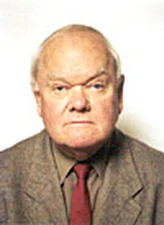Jean-Louis Le Mouël

The 2005 Petrus Peregrinus Medal is awarded to Jean-Louis Le Mouël for his innovative leadership in a very broad spectrum of topics in geomagnetism.
Jean-Louis Le Mouël can be seen as a pioneer in the world of geomagnetism. Although a mathematician by taste and training, he always took a keen interest in advancing instrument design and measurement techniques. As director of the French magnetic observatory of Chambon La Forêt, he provided leadership in magnetic observations in France, ensuring that the French magnetic observatory operates to the highest standards, and had a major influence on the global network of magnetic observatories through his long involvement with and commitment to the Intermagnet programme. Many of his scientific contributions result from this elegant combination involving his permanent efforts to perform very accurate measurements and their use to develop new models and theory. His contributions range from theoretical studies of the workings of the Earth’s core to studies applying modern mathematical characterisations of dynamical systems to analyse long series of magnetic observatory data. A typical example is the assembly of a geomagnetic time series at Paris going back four centuries, or the clever idea of using balloons to make random magnetometer surveys with excellent crustal resolution.
Among his many significant contributions, we mention the first observations (with Vincent Courtillot and Joël Ducruix) suggesting a magnetic impulse in 1969, and his subsequent work relating the implications of these jerks for lower mantle conductivity and their consequence on the length-of-day. Another significant step was the discovery that tangential geostrophy can be applied to the upper core and hence the possibility to use magnetic secular variation to infer fluid motions at the top of the core. Other studies were related to the conductivity in the crust, the influence of mechanical torques between core and mantle on magnetic field variations and length of day, and to his rigourous mathematical work on studies of the external field and relations between magnetic variations, solar activity and climate change.
In addition to his wide-ranging and original contributions to fundamental research of the many aspects of geomagnetism, Jean-Louis Le Mouël has been interested in various aspects of geophysics. His recent work involves studies of multiscale systems, thermal perturbations in cavities, or electrical changes induced by ascending motions of sap in trees.
During his career at the Institut de Physique du Globe de Paris, Prof. Le Mouël has been a senior figure in the organisation. During his 10 year term as Director, he stimulated a very productive environment and can take credit for the vigour and success of the research of IPGP, often in areas apparently remote from his own. He also was responsible for a wide range of french activities in geophysics and at various positions in the french science organisation.
Jean-Louis LeMouël’s record of research puts him in the top flight of research scientists in geophysics worldwide. His bright imagination and originality fits remarkably well with the spirit of Petrus Peregrinus, in addition to the fact that he is well-versed in latin, and an earlier admirer of Peregrinus’ rarely recognised contributions. The EGU is therefore very pleased to welcome Jean Louis Le Mouël as the first Petrus Peregrinus medalist.
